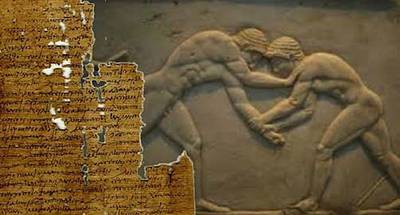
The value of physical education is revived in modern Greece in the 19th century, along with interest in reviving the Olympic Games, which began with the Greek Revolution (1821-1832), also known as the Greek War of Independence from the Ottoman Empire. The history of modern Greece covers the period of its national liberation from Ottoman rule and recognition of its autonomy by the Great Powers (Great Britain, France, and Russia) in 1828 to the present day. Following its liberation from ottoman sovereignty athleticism, physical education, interest in cultivating mind and body, is steadily revived in Greece, the home of the ancient Olympic Games in Olympia (776 BC).
Some dates to remember
♦ 1833: Poem by Alexandros Soutsos proposing the revival of the Olympic Games is published in the newspaper Helios (Sun) in Nauplion, the first capital of the new Greek state. However, it was his brother, Panagiotis Soutsos, who first referred to the revival of the Olympic Games in his poetry Dialogue of the Dead in 1833.
♦ 1856: Evangelos Zappas, Greek patriot, philanthropist and Olympic entrepreneur offers to fund the permanent revival of the Olympic Games and King Otto of Greece approves his request.
♦ 1859: The first Olympics held in the city square of Athens, sponsored by Zappas. He also finances the restoration of the ancient Panathenaic Stadium to host all future Olympic Games.
♦ 1870: The Panathenaic Stadium, also known as Kallimármaro, hosted the Olympics in 1870 (30,000 spectators).
♦ 1875: Olympics hosted at the Panathenaic Stadium and financed by Zappas. The 3rd Olympiad was organized by the Director of the Public/Central Gymnasium, Ioannis Fokianos, who excluded all participants except for university students, trained in the Public Gymnasium in Athens in a series of gymnastic exercises introduced by Fokianos and inspired from the German system of gymnastics
♦ 1879: Ioannis Fokianos appointed Director of the Central/Public Gymnasium, later renamed “Fokianos Gymnasium”. It is here that he created the foundations to organize the fourth Zappeian Olympiad in 1889, the 1890 sporting competitions and the establishment of the National Sporting Club, of which he was the first chairman (1891-1896).
♦ 1879: The introduction of physical education discussed in Athens at the first Congress of Educational Associations operating within liberated/independent Greece as well as outside the borders of the Greek state.
♦ 1880: Physical Education becomes compulsory in public schools.
♦ 1882: The history of educating-training gymnasts in modern Greece begins with the informal operation of the School of Gymnastics (program duration 40 days).
♦ 1891: Establishment of a School of Gymnastics with a one-year program for men and a six-month program for women. This being the initiative of Ioannis Fokianos, the founder of the National Athens Gymnasium (also known as the the Public/Central Gymnasium) opposite the Panathenaic Stadium.
♦ 1896: The first Olympic Games to come under the auspices of the International Olympic Committee (IOC) held in Athens. Greek scholar Demitrios Vikelas was the first IOC President.
♦ 1899: “School for Gymnasts” founded in Athens, which included theoretical classes.
♦ 1918: Establishment of the two-year “Gymnastics for Teachers Academy/School ”
♦ 1932: “Gymnastics Academy”, a three year Higher Education Institution.
♦ 1939: The National Academy of Physical Education, three-year program
♦ 1975: The National Academy of Physical Education, four year program with the first specializations/majors created.
♦ 1982: The Faculty of Physical Education and Sport Science of the National and Kapodistrian University of Athens.
♦ 2013: The School of Physical Education and Sport Science of the National and Kapodistrian University of Athens.